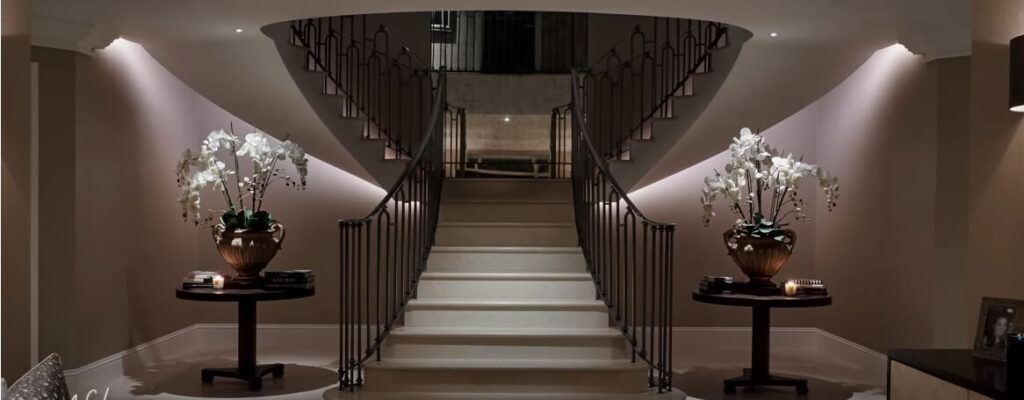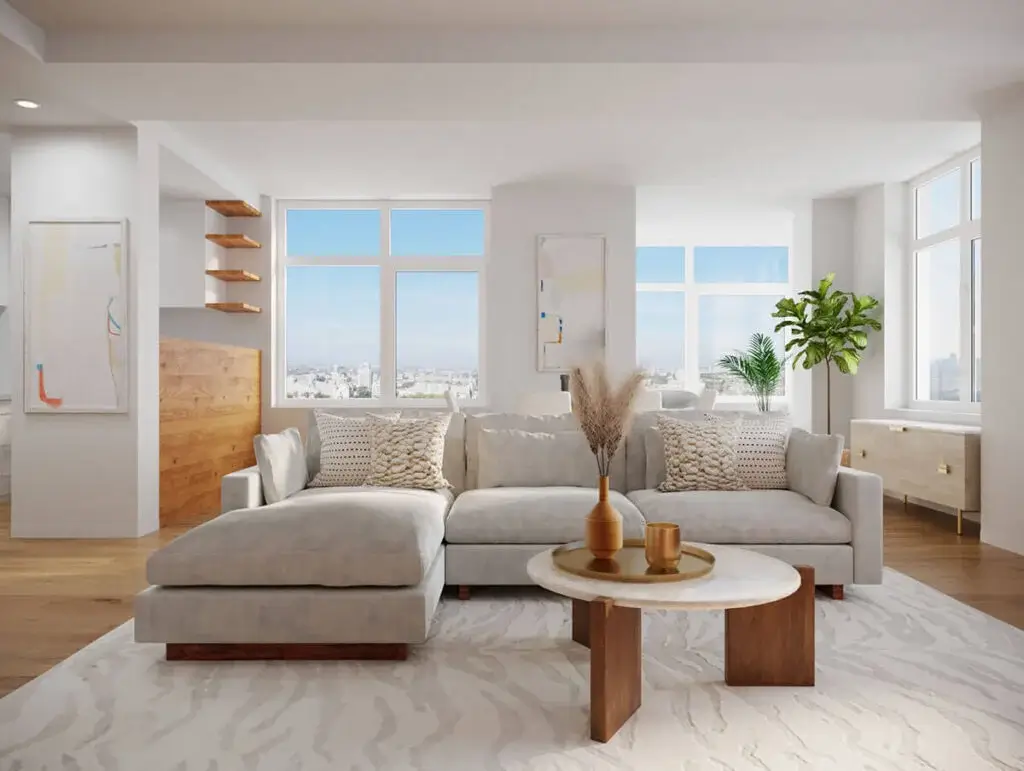Lighting is an essential element of interior design, and it has a major impact on the overall look and feel of any room. Proper lighting can make or break a space, so it’s important to get it right when styling premium interiors. It not only illuminates your home but also sets the mood by creating ambiance.
Depending on the type of lighting used, you can create different effects that draw attention to certain parts of your decor or highlight unique features in a space. For example, accent lights are great for drawing attention to certain art pieces or architectural details while wall sconces provide soft light that creates an inviting atmosphere in entryways and hallways. In addition, good lighting helps create visual balance throughout the house as well as conveying a sense of luxury and sophistication with its ability to bring out colors in furniture fabrics and artwork more effectively than natural light alone.
Lighting plays an essential role in interior styling and should not be overlooked when creating your dream home. Proper lighting can help to create a cozy atmosphere, enhance the character of a room, and bring out the best features of each space. Layering different lighting sources like wall sconces, floor lamps and pendant lights will add depth to any room’s design.
Additionally, adding accents such as dimmers or colored bulbs can further customize the look for a truly unique experience. Investing time and energy into designing your ideal lighting setup is sure to pay off in the end with beautiful results that you’ll love for years to come!

Why is Lighting So Important in Interior Design?
Lighting is an integral part of every interior design, as it can drastically change the look and feel of a room. Lighting plays a crucial role in setting the mood and atmosphere for any space, and it can also be used to highlight certain features or create contrast between different areas. Proper lighting helps you to see properly within a space, making sure that all surfaces are illuminated correctly.
It also provides safety for occupants by allowing them to find their way around without stumbling over furniture or objects in low light conditions. Additionally, lighting can be used to accentuate textures, colors and shapes; this is especially important if you want your rooms to stand out from the rest with unique designs that capture the attention of everyone who enters them. Furthermore, having adjustable layers of lighting allows people to easily adjust their environment based on whether they’re entertaining company or just unwinding after work.
All these reasons make it clear why lighting is such an essential factor in interior design – without it our spaces would be much less inviting!
What is the Importance of Lighting in Fashion?
Lighting plays a major role in fashion photography and is essential for creating the desired atmosphere. It has the ability to transform a simple outfit into something extraordinary, giving it depth, texture and character. Good lighting can make an otherwise dull image come alive and evoke emotion in viewers.
Lighting affects how people perceive fashion – it shapes our perception of what looks good and bad on camera, allowing us to create unique images that capture attention and inspire interest. With creative lighting techniques like backlighting or softening harsh shadows with reflectors, photographers can bring out certain elements within an image that draw attention to specific details such as fabrics or silhouettes of garments. Plus, when used correctly lighting can help emphasize certain features such as facial expressions or body language which are key components in conveying stories through fashion imagery.
In conclusion, lighting is one of the most important aspects of fashion photography; its ability to transform an outfit from plain to remarkable makes it crucial for creating memorable visuals that capture viewers’ imaginations.
What are the Most Important Components of Lighting for Interiors?
When it comes to lighting for interiors, there are several components that need to be taken into consideration. The most important of these would include the type of bulbs used, the positioning and direction of lights, as well as the color temperature and intensity. Bulbs come in many different types such as LED, incandescent and fluorescent, each having its own advantages and disadvantages when it comes to interior lighting.
Positioning is also key – too much light can make an area uncomfortable while not enough can lead to a feeling of gloominess or disorientation. Furthermore, choosing the right color temperature will ensure your space has just the right ambience; warm colors create a cozy atmosphere while cooler tones give off a more modern feel. Lastly, controlling intensity will help you achieve balance between brightness and darkness which should be adjusted depending on whether you’re looking for task-based or ambient lighting solutions.
All in all, if given careful thought and consideration during installation time then these four components –bulb type, position/directionality, color temperature & intensity –should provide you with ideal interior lighting setup for any room or space!
What are the Effects of Lighting in Interior Design?
Lighting plays an important role in interior design as it has the power to create a mood, accentuate features and even change an entire space. When used correctly, lighting can be used to highlight specific areas of a room or provide ambient light for overall illumination. Properly placed lights can also make a room look larger and more inviting.
Lighting affects how people feel in the space and can help set the tone for a particular activity such as reading or relaxing. For example, bright overhead lights are best suited for activities that require intense concentration while softer lamps with warm hues may be better suited for resting areas where comfort is key. Additionally, various types of lighting fixtures such as pendants, chandeliers and wall sconces can all add their own unique element to any given space.
Finally, natural light from windows is often preferred over artificial lighting due to its ability to bring warmth into an otherwise dull area; this provides another layer of depth which helps keep the atmosphere feeling open and airy rather than stale or stuffy.
All together these elements come together to form what we call “lighting design” –a carefully curated selection of different luminaires (light fixtures) designed specifically with each individual space in mind- creating both form. And function within an environment that not only looks great but also feels comfortable too!
How to Shoot Interior Design Photography in 2023 – 7 Tips
Types of Lighting in Interior Design
Lighting is an important element when it comes to interior design, as it can dramatically change the atmosphere of a room. There are several types of lighting that can be used in interior design, such as natural light from windows and doors, accent lighting which highlights certain features or objects within a space, task lighting which focuses on specific areas.
Where you need extra illumination for activities like reading or cooking, ambient lighting which provides general overall lighting throughout the entire room and decorative lighting which adds style and character to your home decor.
Each type of light has its own purpose and should be combined in order to create the perfect balance between function and aesthetics.
What is Lighting in Interior Design
Lighting in interior design is an essential element of creating the perfect atmosphere. It can be used to create dramatic effects, highlight key features, and set the mood for any space. Lighting also has practical uses such as providing task lighting for work surfaces or providing ambient lighting for a comfortable living environment.
Different types of lighting such as track lights, pendant lights, wall sconces, and table lamps provide different levels of illumination and are used to create unique looks in any home or office setting.
Importance of Lighting in Interior Design Ppt
Good lighting design is an essential element in interior design. It can add warmth, drama, and interest to a space while also providing task lighting for activities such as reading or cooking. Additionally, proper light placement can create the illusion of depth and dimension within a room by highlighting certain areas or objects while shadowing others.
When used creatively, lighting can be one of the most powerful tools available to an interior designer when it comes to creating unique and memorable environments that reflect personal style.
Importance of Lighting in Building
Lighting plays an important role in any building environment, both for functional and aesthetic purposes. Not only does it provide the necessary illumination for activities such as reading or working, but good lighting can also create a pleasant atmosphere that people enjoy spending time in. Properly designed lighting ensures that tasks are completed efficiently with minimal eye strain and discomfort.
Additionally, appropriate levels of light can influence how well a space is perceived by setting the mood and highlighting architectural features within a room.
Importance of Lighting in Home
Lighting is an essential part of any home and can be used to create a variety of moods, depending on the type of light chosen. Properly placed lighting adds visual interest and enhances the aesthetic beauty of your home while providing safety and security. The right lighting can also make it easier to navigate around the house, allowing you to see clearly in dark areas or poorly lit spaces.
Lighting is a great way to add ambiance and style, as well as making sure that your home looks its best day or night.
Task Lighting in Interior Design
Task lighting is an important element of interior design. It provides focused, directional light that can be used to illuminate specific areas or activities within a room. This type of lighting is great for task-oriented tasks such as reading and studying, but it can also help to create atmosphere in certain areas of the home.
Task lighting should be incorporated into any design plan to improve functionality and aesthetics.
Artificial Lighting in Interior Design
Artificial lighting is a key tool for interior design. It can be used to create atmosphere, highlight features and objects in the room, and even provide functional light for tasks such as reading or cooking. When choosing artificial lighting fixtures, it’s important to consider both form and function – both the aesthetic elements of the fixture and its ability to properly illuminate the space.
Consider layering different types of lights (such as wall sconces, table lamps, pendants) to achieve your desired effect while also providing adequate illumination throughout the room.
Conclusion
In conclusion, lighting is a key component of interior styling that can have a major impact on the atmosphere and mood of any space. From ambient to task lighting, there are many different ways to bring light into your home for both aesthetic and practical purposes.
Careful consideration should be given when selecting fixtures as part of an overall design plan in order to achieve the desired effect.
With its ability to transform any room from mundane to magnificent, lighting is truly essential in creating luxurious interiors with premium style.


